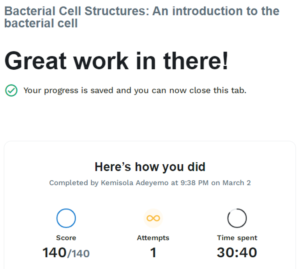COURSE
SCIE1046: Fundamentals Of Microbiology With Lab

- About the Lab
Learning Objectives:
- Describe the general bacterial cell structure and function, including differentiating between the most common shapes of bacteria and cell arrangements.
- Describe the general bacterial cytoplasmic content and compare it to eukaryotic cytoplasmic content.
- Describe special features of bacteria such as plasmids, flagella, or inclusion bodies and how they are necessary for bacteria to survive.
Estimated Length: 35 minutes to 45 minutes
MAKE THE CONNECTION
The background information in section 2 was adapted from the following Microbiology lecture course Tutorials:
1.1.4 Types and Characteristics of Microorganisms
1.2.3 Types of Microscopes
1.3.3 Prokaryotic Cells
- Background Information
The following background information will be helpful as you prepare for the simulation.
2a. General Characteristics of Microorganisms
Microbes differ in characteristics such as size, structure, habitat, metabolism, genetics, and more. Very broadly, microbes can be classified as acellular (without cells) or cellular. Prokaryotes and eukaryotes both have cells but differ in whether their cells have nuclei. However, acellular agents such as viruses do not have cells at all.
Prokaryotic microorganisms are single-celled organisms that lack a true membrane-bound nucleus. The two major groups of prokaryotes are classified within domains Bacteria and Archaea.
Eukaryotic microorganisms all have cells that contain true membrane-bound nuclei. They include protists (such as algae) as well as fungi and helminths (which are worms).
2b. Light Microscopes
There are many types of light microscopes, which use light to visualize images. Early microscopes used light and light microscopes are still widely used. However, different types of light microscopes have been developed to address specialized needs. In particular, many microorganisms are almost translucent and different types of light microscopes increase contrast. It is valuable to understand the advantages and disadvantages of different types of microscopes.
2c. Prokaryotic Cells
You are encouraged to review the complete Microbiology lecture course Tutorial 1.3.3 Prokaryotic Cells for background on this topic before you begin the simulation.
- Lab Manual
Lab Manual – Bacterial Cell Structures: An introduction to the bacterial cell
This Lab Manual gives a synopsis of the lab and the theory behind it. You’re encouraged to read or download the manual before launching the lab. This information will also be available during the simulation by selecting the “Theory” tab on the virtual LabPad.
4. Launch Lab
You’re ready to begin! Review the helpful navigation tips below. Then click the Launch Lab button to start your lab. Be sure to answer all the questions in the simulation because they contribute to your score. Good luck, scientists!
- Exiting: To exit a lab simulation, press the ESC key on your keyboard. This key returns you to the objective screen for the simulation.
- Saving: You do not need to complete a simulation in one sitting. Labster saves your progress at predetermined checkpoints upon exit. To see your progress at any time, click on the mission tab of the LabPad.
- Restarting: You are allowed an unlimited number of restarts for a simulation to improve your quiz score. Sophia and Labster will always store your best score.
- Just Browsing: You can restart a simulation to have a look around without completing it. The program will still retain your previous (and best) score.
